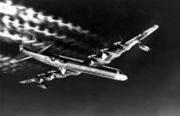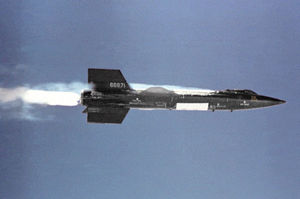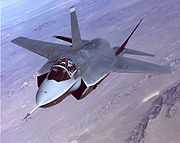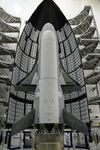List of X-planes

The X-planes are a series of experimental United States airplanes and helicopters (and some rockets) used for the testing and evaluation of new technologies and aerodynamic concepts. Some members of the series have been well publicised, while others, such as the X-16 project, have been developed in secrecy.[1]
The first of the X-planes, the Bell X-1, became well known as, in 1947, it was the first aircraft to break the sound barrier in level flight.[2] Later X-planes yielded important research results in a multitude of aerodynamic and technical fields, but only the North American X-15 rocket plane of the early 1960s achieved comparable fame to that of the X-1. X-planes 7 through 12 were actually missiles,[3] and some other vehicles were unpiloted. Most X-planes are not expected to go into full-scale production, however an exception to the rule was the Lockheed Martin X-35, which competed against the Boeing X-32 in a fly-off as part of the Joint Strike Fighter Program, and is expected to enter production as the F-35.[4]
Most of the X-planes have been operated by the National Advisory Committee for Aeronautics (NACA) or, later, the National Aeronautics and Space Agency (NASA), often in conjunction with the United States Air Force. However, not all US experimental aircraft have been designated in the X-plane series; some received U.S. Navy designations prior to 1962,[5] while others have been known only by manufacturers' designations,[N 1] non-'X'-series designations,[N 2] or classified codenames.[N 3]
Contents |
List of X-planes
| Name | Manufacturer Agency |
Image | Maiden flight | Notes |
|---|---|---|---|---|
| X-1 | Bell Aircraft USAF, NACA |
 |
January 19, 1946 | High-speed and high-altitude testing. First aircraft to break the sound barrier. Proved aerodynamic viability of thin wing sections.[6] |
| X-2 "Starbuster" |
Bell Aircraft USAF |
 |
June 27, 1952 | High-speed and high-altitude testing. First aircraft to exceed Mach 3.[7] |
| X-3 Stiletto |
Douglas Aircraft USAF, NACA |
 |
October 27, 1952 | Titanium alloy construction; low aspect ratio wings. Planned to test long-duration high-speed flight. Incapable of reaching design speed, but Provided insights into inertia coupling.[8] |
| X-4 Bantam |
Northrop USAF, NACA |
 |
December 15, 1948 | Evaluated handling characteristics of tailless aircraft in the transonic speed region.[9] |
| X-5 | Bell Aircraft USAF, NACA |
 |
June 20, 1951 | First aircraft to fly with variable geometry wings.[10] |
| X-6 | Convair USAF, AEC |
 |
Not flown | Modified Convair B-36 for study of Aircraft Nuclear Propulsion; not built. NB-36H testbed tested reactor.[11] |
| X-7 "Flying Stove Pipe" |
Lockheed Tri-service |
April 1951 | High-speed testbed for ramjet engines.[12] | |
| X-8 Aerobee |
Aerojet NACA, USAF, USN |
Upper air research vehicle and sounding rocket.[13] | ||
| X-9 Shrike |
Bell Aircraft USAF |
April 1949 | Guidance and propulsion technology testbed. Assisted development of GAM-63 Rascal missile.[14] |
|
| X-10 | North American Aviation USAF |
October 13, 1953 | Testbed for SM-64 Navajo missile.[15] | |
| X-11 | Convair USAF |
 |
June 11, 1957 | Testbed for SM-65 Atlas missile.[16] |
| X-12 | Convair USAF |
July, 1958 | Advanced testbed for SM-65 Atlas missile.[17] | |
| X-13 Vertijet |
Ryan Aeronautical USAF, USN |
 |
December 10, 1955 | Vertical takeoff and landing (VTOL) testbed. Evaluated tailsitting configuration for VTOL flight.[18] |
| X-14 | Bell Aircraft USAF, NASA |
 |
February 19, 1957 | VTOL testbed. Examined the vectored thrust configuration for VTOL flight.[19] |
| X-15 | North American Aviation USAF, NASA |
 |
June 8, 1959 | Hypersonic (Mach 6), high-altitude (350,000 feet (110,000 m)) testing. First manned hypersonic aircraft; capable of suborbital spaceflight.[20] |
| X-16 | Bell Aircraft USAF |
Never flew | High-altitude reconnaissance aircraft project.[21] "X-16" designation used as cover story.[22] |
|
| X-17 | Lockheed USAF, USN |
April 1956 | Tested the effects of high Mach number reentry.[23] | |
| X-18 | Hiller Aircraft USAF, USN |
 |
November 24, 1959 | VTOL/Short take-off and vertical landing (STOVL) testbed. Evaluated the tiltwing concept for VTOL flight.[24] |
| X-19 | Curtiss-Wright Tri-service |
November 1963 | Tandem tiltrotor VTOL transport testbed.[25] XC-143 designation proposed.[26] |
|
| X-20 Dyna-Soar |
Boeing USAF |
 |
Never built | Reusable spaceplane for military missions.[27] |
| X-21 | Northrop USAF |
 |
April 18, 1963 | Boundary layer control testbed.[28] |
| X-22 | Bell Aircraft Tri-service |
 |
March 17, 1966 | Quad ducted fan tiltrotor STOVL testbed.[29] |
| X-23 PRIME |
Martin Marietta USAF |
December 21, 1966 | Manuvering atmospheric reentry effects testbed.[30] Note: Designation never officially assigned.[31] |
|
| X-24 | Martin Marietta USAF, NASA |
  |
August 1, 1973 | Low-speed lifting body handling testbed. Lifting body aerodynamic shape trials.[32] |
| X-25 | Benson USAF |
 |
December 6, 1955 | Light autogyro for emergency use by downed pilots.[33] |
| X-26 Frigate |
Schweizer DARPA, US Army, USN |
  |
1967 | Training glider for yaw-roll coupling Quiet observation aircraft testbed.[34] |
| X-27 | Lockheed |  |
Never flew | High performance fighter prototype.[35] |
| X-28 Sea Skimmer |
Osprey Aircraft USN |
 |
August 12, 1970 | Inexpensive aerial policing seaplane testbed.[36] |
| X-29 | Grumman DARPA, USAF, NASA |
1984 | Forward-swept wing testbed.[37] | |
| X-30 NASP |
Rockwell NASA, DARPA, USAF |
 |
Never built | Single stage to orbit spaceplane prototype.[38] |
| X-31 | Rockwell DARPA, USAF, BdV |
1990 | Thrust vectoring supermaneuverability testbed. ESTOL testbed.[39] |
|
| X-32 | Boeing USAF, USN, RAF |
 |
September 2000 | Joint Strike Fighter prototype.[40] |
| X-33 Venture Star |
Lockheed Martin NASA |
 |
Prototype never completed | Half-scale reusable launch vehicle prototype.[41] |
| X-34 | Orbital Sciences NASA |
 |
Never flew | Reusable unmanned spaceplane testbed.[42] |
| X-35 | Lockheed Martin USAF, USN, RAF |
 |
2000 | Joint Strike Fighter prototype.[43] |
| X-36 | McDonnell Douglas/Boeing NASA |
 |
May 17, 1997 | 28% scale tailless fighter testbed.[44] |
| X-37 | Boeing USAF, NASA |
 |
April 7, 2006 (drop test) April 22, 2010 (orbital flight) |
Reusable orbital spaceplane.[45] |
| X-38 | Scaled Composites NASA |
 |
1999 | Lifting body Crew Return Vehicle demonstrator.[46] |
| X-39 | Unknown USAF |
Classified | Unknown | Future Aircraft Technology Enhancements (FATE) program.[47] Note: Designation never officially assigned.[31] |
| X-40 | Boeing USAF, NASA |
August 11, 1998 | 80% scale Space Maneuver Vehicle testbed. X-37 prototype.[48] |
|
| X-41 | Unknown USAF |
Classified | Unknown | Maneuvering re-entry vehicle.[49] |
| X-42 | Unknown USAF |
Classified | Unknown | Expendable liquid propellant upper stage rocket.[50] |
| X-43 Hyper-X |
Microcraft NASA |
 |
June 2, 2001 | Scramjet hypersonic testbed.[51] |
| X-44 MANTA |
Lockheed Martin USAF, NASA |
Cancelled | F-22-based Multi-Axis No-Tail Aircraft thrust vectoring testbed.[52] | |
| X-45 | Boeing DARPA, USAF |
May 22, 2002 | Unmanned combat air vehicle (UCAV) demonstrator.[53] | |
| X-46 | Boeing DARPA, USN |
 |
Cancelled | Naval UCAV demonstrator.[54] |
| X-47A Pegasus X-47B |
Northrop Grumman DARPA, USN |
 |
February 23, 2003 | Naval UCAV demonstrator.[55] |
| X-48 | Boeing NASA |
 |
July 20, 2007 | Blended Wing Body (BWB) testbed.[56] |
| X-49 Speedhawk |
Piasecki Aircraft US Army |
 |
July 29, 2007 | Compound helicopter Vectored Thrust Ducted Propeller (VTDP) testbed.[57] |
| X-50 Dragonfly |
Boeing DARPA |
 |
24 November 2003 | Canard Rotor/Wing testbed.[58] |
| X-51 Waverider |
Boeing USAF |
 |
26 May 2010[59] | Hypersonic scramjet demonstrator.[60] |
| X-52 | Number skipped to avoid confusion with B-52.[31] | |||
| X-53 | Boeing Phantom Works NASA, USAF |
 |
November 2002 | Active Aeroelastic Wing testbed.[61] |
| X-54 | Gulfstream Aerospace NASA |
Future | Supersonic transport testbed.[57] | |
| X-55 | Lockheed Martin Skunk Works USAF |
 |
June 2, 2009 | Advanced Composite Cargo Aircraft (ACCA). Molded composite fuselage and empennage testbed.[62] |
See also
- Experimental aircraft
- List of experimental aircraft
- List of military aircraft of the United States
References
- Notes
- Citations
- ↑ Miller 2001, p. 209
- ↑ "First Generation X-1". NASA Dryden Fact Sheets. NASA. Accessed May 8 2010.
- ↑ Miller 2001
- ↑ A history of the Joint Strike Fighter Program, Martin-Baker. Retrieved January 2010
- ↑ "D-558-I" NASA Dryden Fact Sheets. NASA. Accessed May 8 2010.
- ↑ Jenkins, Landis and Miller 2003, pp. 5-7.
- ↑ Jenkins, Landis and Miller 2003, p. 8.
- ↑ Jenkins, Landis and Miller 2003, p. 9.
- ↑ Jenkins, Landis and Miller 2003, p. 10.
- ↑ Jenkins, Landis and Miller 2003, p. 11.
- ↑ Jenkins, Landis and Miller 2003, p. 12.
- ↑ Jenkins, Landis and Miller 2003, p. 13.
- ↑ Jenkins, Landis and Miller 2003, p. 14.
- ↑ Jenkins, Landis and Miller 2003, p. 15.
- ↑ Jenkins, Landis and Miller 2003, p. 16.
- ↑ Jenkins, Landis and Miller 2003, p. 17.
- ↑ Jenkins, Landis and Miller 2003, p. 18.
- ↑ Jenkins, Landis and Miller 2003, p. 19.
- ↑ Jenkins, Landis and Miller 2003, p. 20.
- ↑ Jenkins, Landis and Miller 2003, pp. 21-22.
- ↑ Jenkins, Landis and Miller 2003, p. 23.
- ↑ "X-16". globalsecurity.org, accessed 11 May 2010.
- ↑ Jenkins, Landis and Miller 2003, p. 24.
- ↑ Jenkins, Landis and Miller 2003, p. 25.
- ↑ Jenkins, Landis and Miller 2003, p. 26.
- ↑ Baugher 2007
- ↑ Jenkins, Landis and Miller 2003, p. 27.
- ↑ Jenkins, Landis and Miller 2003, p. 28.
- ↑ Jenkins, Landis and Miller 2003, p. 29.
- ↑ Jenkins, Landis and Miller 2003, p. 30.
- ↑ 31.0 31.1 31.2 Parsch 2009, "Missing Designations"
- ↑ Jenkins, Landis and Miller 2003, pp. 31-32.
- ↑ Jenkins, Landis and Miller 2003, p. 33.
- ↑ Jenkins, Landis and Miller 2003, p. 34.
- ↑ Jenkins, Landis and Miller 2003, p. 35.
- ↑ Jenkins, Landis and Miller 2003, p. 36.
- ↑ Jenkins, Landis and Miller 2003, p. 37.
- ↑ Jenkins, Landis and Miller 2003, p. 38.
- ↑ Jenkins, Landis and Miller 2003, p. 39.
- ↑ Jenkins, Landis and Miller 2003, pp. 40-41.
- ↑ Jenkins, Landis and Miller 2003, p. 42.
- ↑ Jenkins, Landis and Miller 2003, p. 43.
- ↑ Jenkins, Landis and Miller 2003, p. 44-45.
- ↑ Jenkins, Landis and Miller 2003, p. 46.
- ↑ Jenkins, Landis and Miller 2003, p. 47.
- ↑ Jenkins, Landis and Miller 2003, p. 48.
- ↑ Jenkins, Landis and Miller 2003, p. 49.
- ↑ Jenkins, Landis and Miller 2003, p. 50.
- ↑ Jenkins, Landis and Miller 2003, p. 51.
- ↑ Jenkins, Landis and Miller 2003, p. 52.
- ↑ Jenkins, Landis and Miller 2003, p. 53.
- ↑ Jenkins, Landis and Miller 2003, p. 54.
- ↑ Jenkins, Landis and Miller 2003, p. 55.
- ↑ Jenkins, Landis and Miller 2003, p. 56.
- ↑ Jenkins, Landis and Miller 2003, p. 57.
- ↑ Jenkins, Landis and Miller 2003, p. 58.
- ↑ 57.0 57.1 Parsch 2009, "DOD 4120.15-L"
- ↑ Jenkins, Landis and Miller 2003, p. 60.
- ↑ "X-51 Waverider makes historic hypersonic flight". US AIr Force Public Affairs. 26 May 2010. http://www.af.mil/news/story.asp?id=123206525. Retrieved 27 May 2010.
- ↑ "X-51 Scramjet Engine Demonstrator - WaveRider" globalsecurity.org. Accessed 2010-05-11.
- ↑ Jordan 2006
- ↑ Kaufman 2009
- Bibliography
- Baugher, Joe (2007). "Cargo Aircraft Designations". http://www.joebaugher.com/ustransports/cdesig.html. Retrieved 11 May 2010.
- Jenkins, Dennis R.; Tony Landis and Jay Miller (June 2003) (PDF). American X-Vehicles: An Inventory—X-1 to X-50 (NASA Special Publication). Monographs in Aerospace History. No. 31 (Centennial of Flight ed.). Washington, DC: NASA History Office. SP-2003-4531. http://history.nasa.gov/monograph31.pdf. Retrieved 5 April 2010.
- Jordan, Holly (2006). "Active Aeroelastic Wing flight research vehicle receives X-53 designation". Wright-Patterson Air Force Base. http://www.wpafb.af.mil/news/story.asp?id=123035661. Retrieved 2010-05-11.
- Kaufman, Derek (2009). "Advanced Composite Cargo Aircraft gets X-plane designation". United States Air Force. http://www.af.mil/news/story.asp?id=123173711. Retrieved 2010-05-11.
- Miller, Jay (2001). The X-Planes: X-1 to X-45 (third ed.). Motorbooks International. ISBN 1-8578-0109-1.
- Parsch, Andreas (November 2009). ""Missing" USAF/DOD Aircraft Designations". designation-systems.net. http://www.designation-systems.net/usmilav/missing-mds.html. Retrieved 2010-05-11.
- Parsch, Andreas (November 2009). "DOD 4120.15-L - Addendum, MDS Designators allocated after 19 August 1998 (until September 2009)". designation-Systems.Net. http://www.designation-systems.net/usmilav/412015-L(addendum).html. Retrieved 2010-05-11.
External links
|
||||||||
|
||||||||||||||